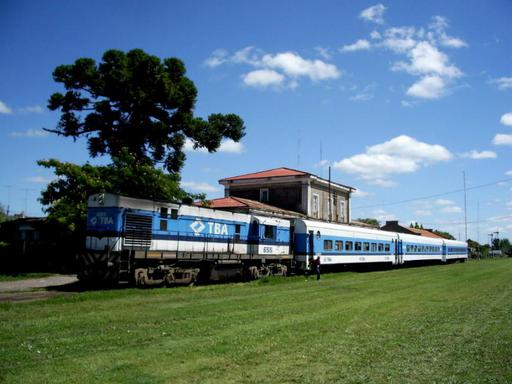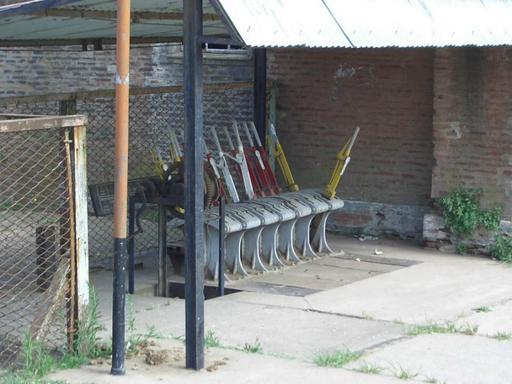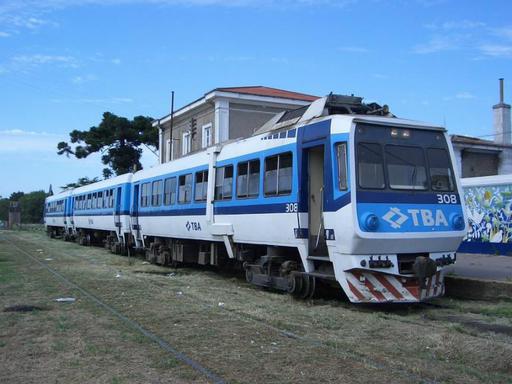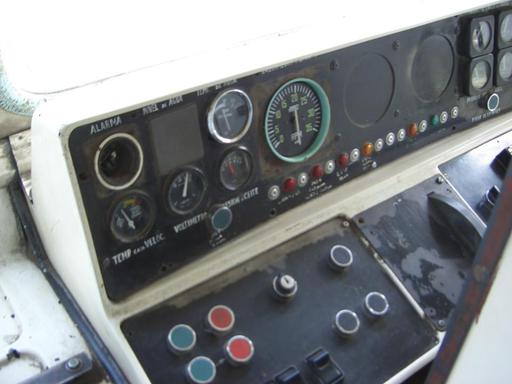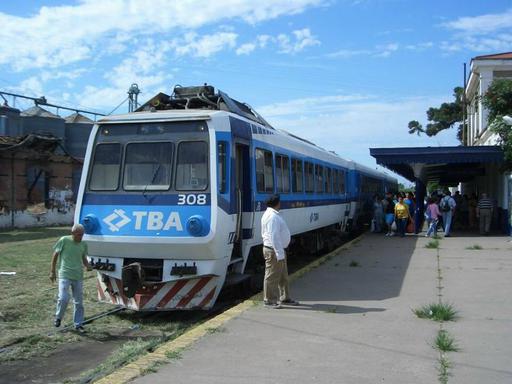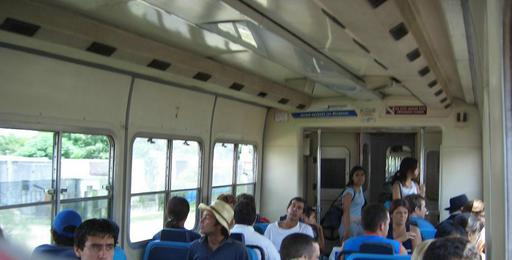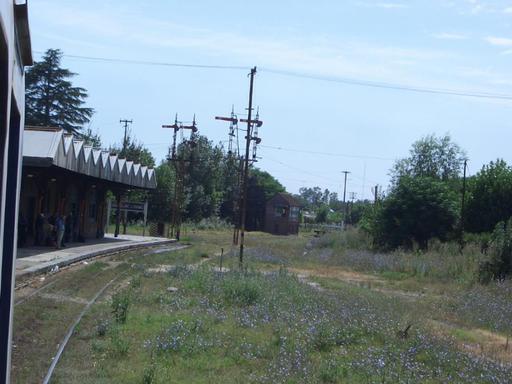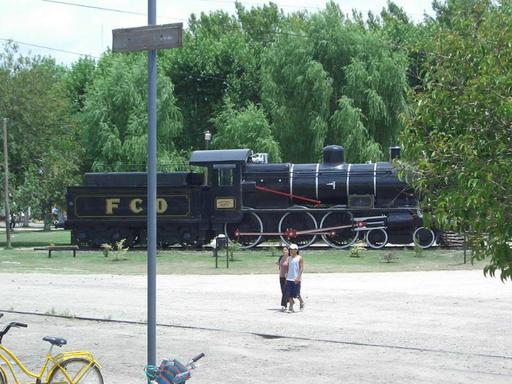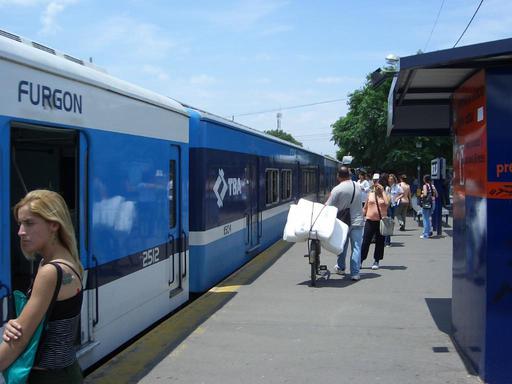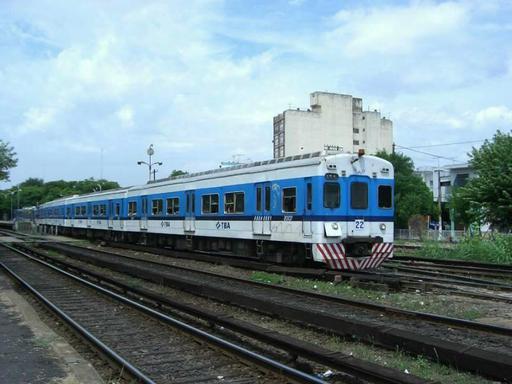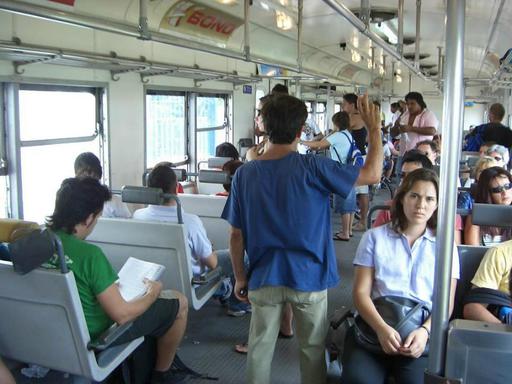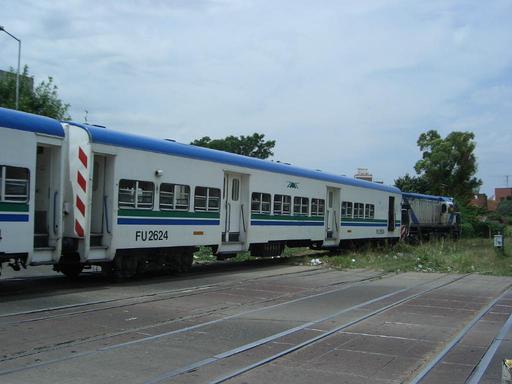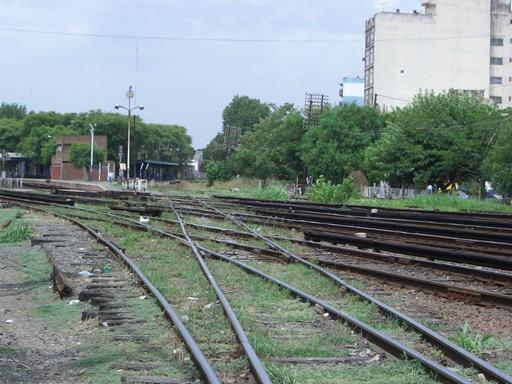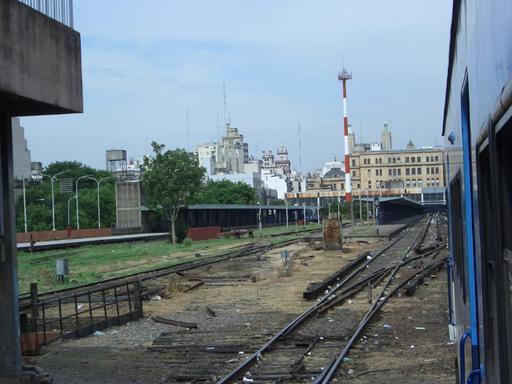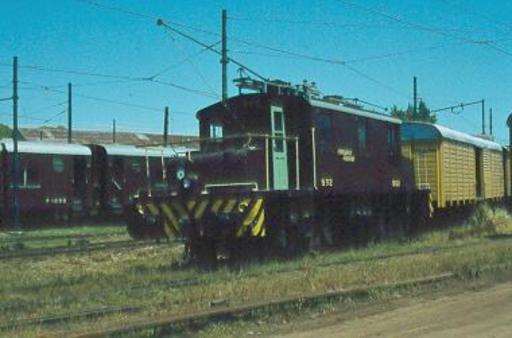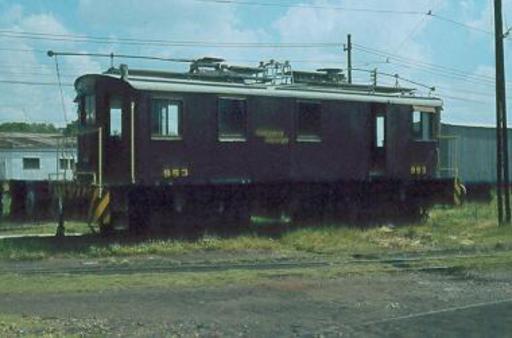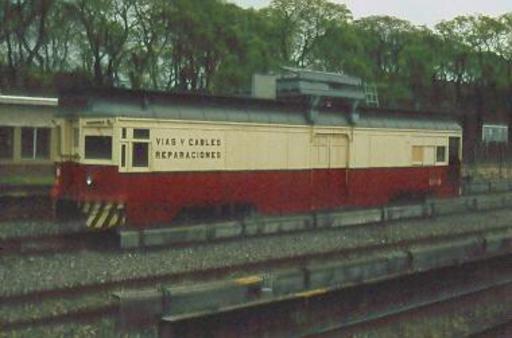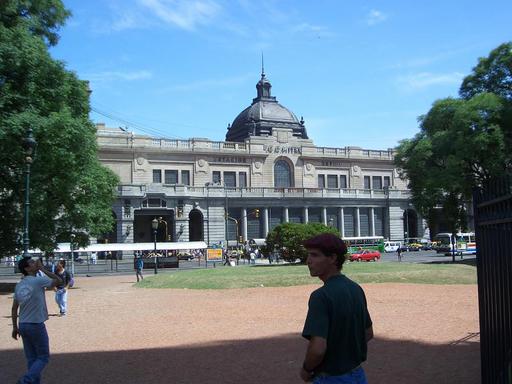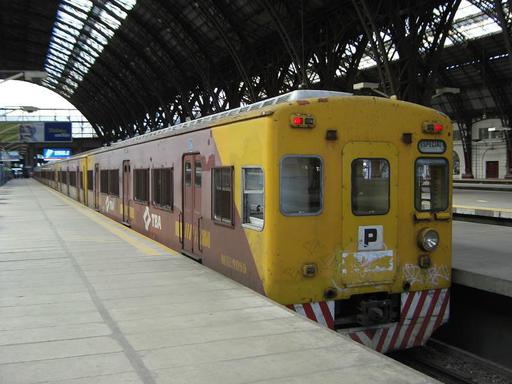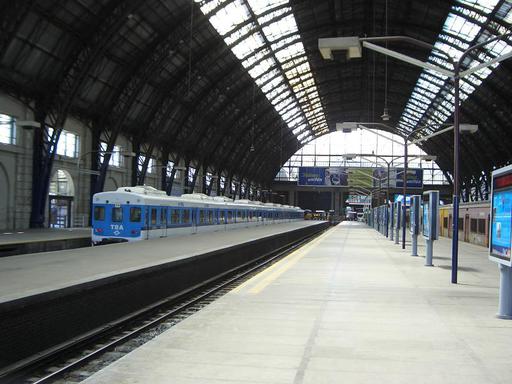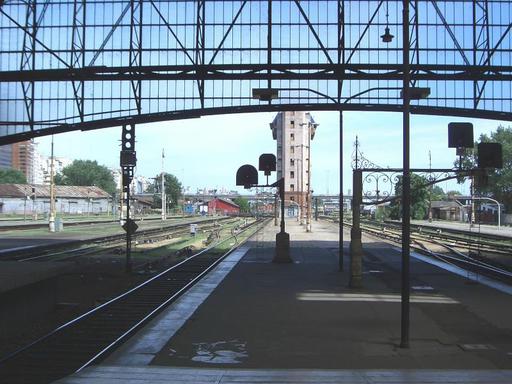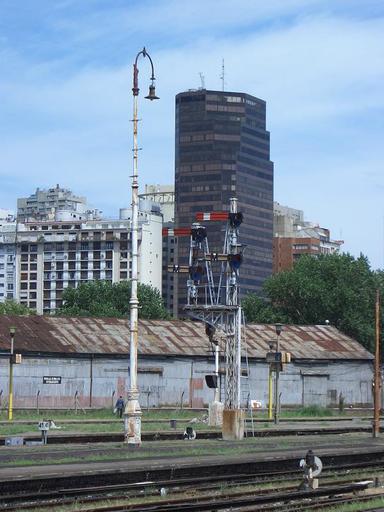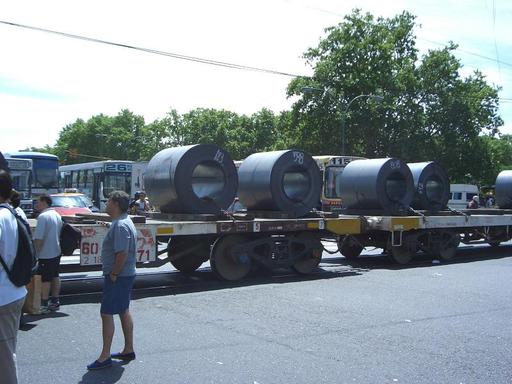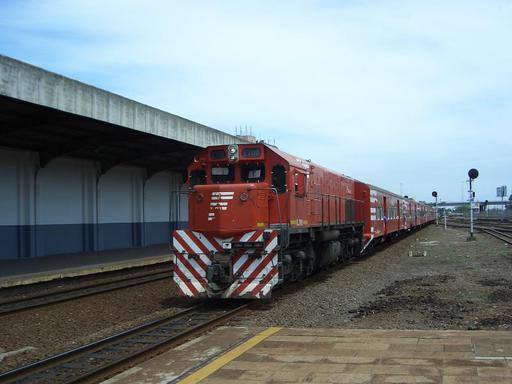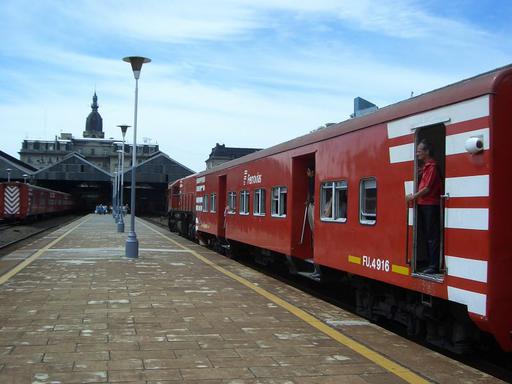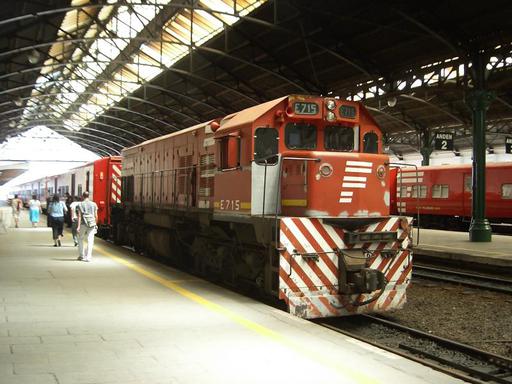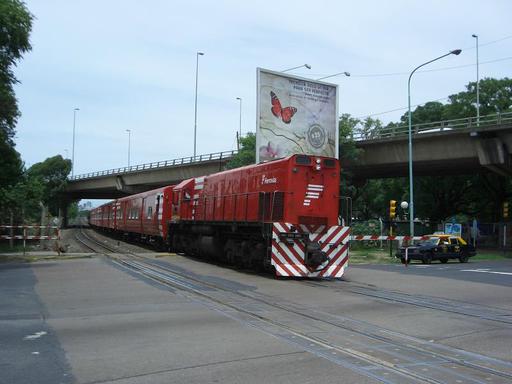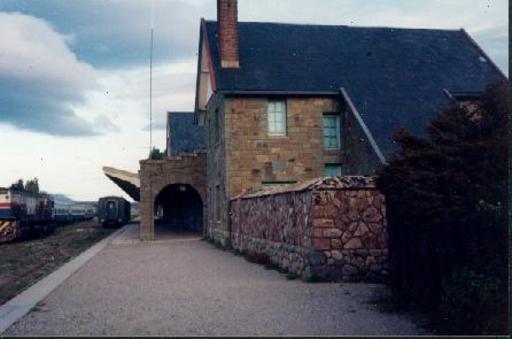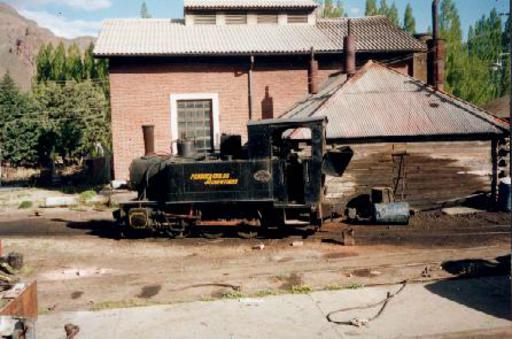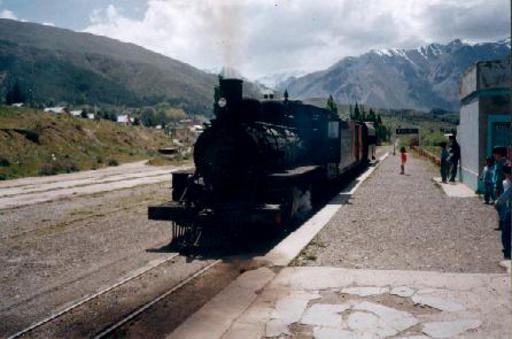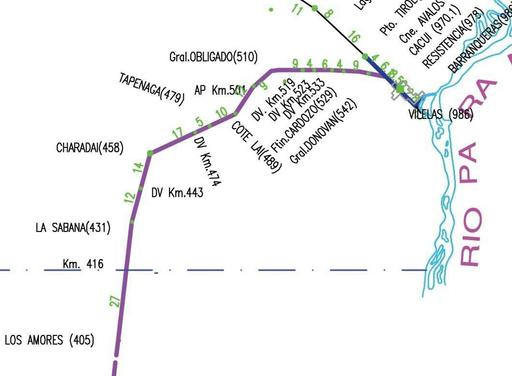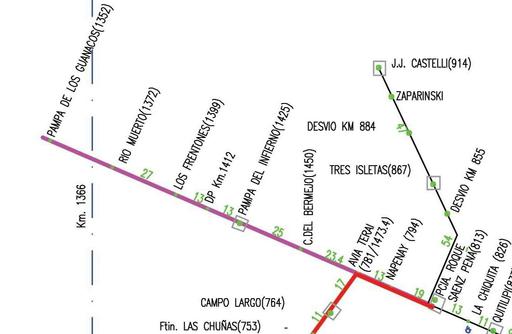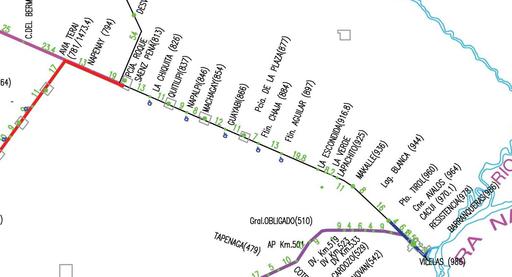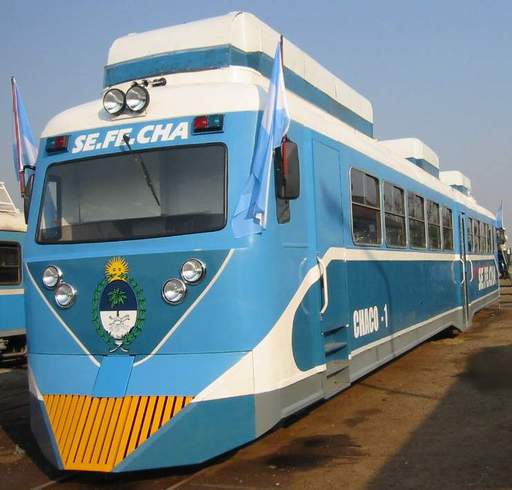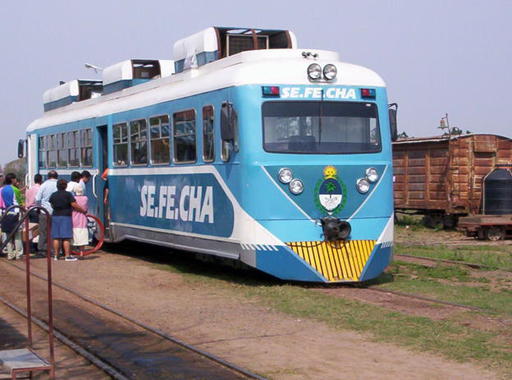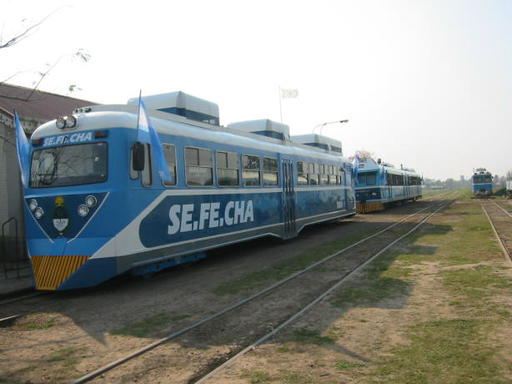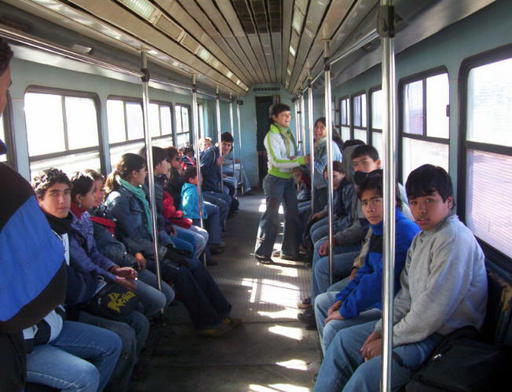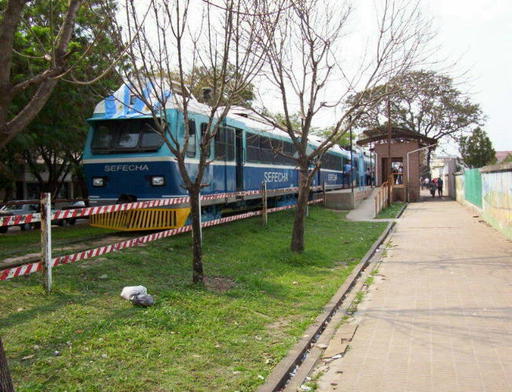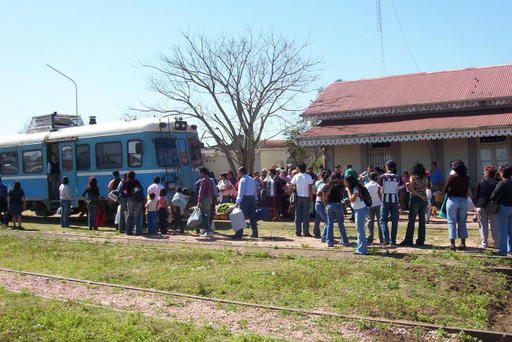Argentinien
FC Sarmiento
In the eighties the suburban railways in the Buenos Aires area were in poor shape. Therefore, the government decided to privatise them. For this purpose, a call for tenders was made, amongst others for the Mitre and Sarmiento lines. Out of a consortium of bus operators the Consorcio Metropolitano de Transporte (Cometrans S.A.) emerged with the purpose to win such tenders. With the new designation "Trenes de Buenos Aires S.A." the group gained the tenders of the Mitre (from Retiro station) and Sarmiento lines (from Once station).
Most tourists will probably know the Mitre lines, as these go to Tigre where boat trips can be taken. The Sarmiento lines are less known. They consist of an electric line (with third rail power pickup) to Moreno from where diesel trains go to Lujan and Mercedes, and a branch line from Merlo to Lobos. In addition, there is a diesel railcar service from Puerto Madero through the tunnel of a former carbon transport line which joins the other lines shortly after Once station and follows them as far as Castelar, a kind of luxury service; these vehicles have air conditioning, heating, carry only seated passengers, offer free newspapers and background music; these trains only stop at Ramos Mejia and Haedo whilst all the other trains stop at all stations. To avoid accidents at the numerous level crossings, it is planned to put the line between Caballito and Moreno underground, and this is to happen in three stages and will take about three years from the start in early 2008. In addition, the signalling system between Once and Liniers shall be renewed, with control from the joint signal cabin 7 at Retiro station.
The electric service has a length of 36 km and counts 266 trains per day with an interval of 6 minutes. In addition, there are 25 trains per day from the underground station Once/Miserere, situated between the tracks of the old and venerable subway line A, and which after a short tunnel run parallel with the other lines as far as Caballito and there the tracks merge with the main line. They operate as far as Castelar with an interval of 34 minutes. From Moreno to Lujan there are 14 trains per day with an interval of about 60 Minutes to Las Heras, and of these on weekdays 11 trains per day, also with an interval of about 60 minutes, to Mercedes. On the line to Lobos there are on weekdays 10 trains with an interval of about 60 minutes as far as Las Heras and of these 8 trains with an interval of about 120 minutes to Lobos. In total, these diesel lines have an extension of 157 km. The Diferencial service Puerto Madero - Castelar has a length of 26 km. In total, 41 stations serve the passengers in the western part of the Capital (the district is called Capital Federal) and in 10 communities in the larger area Gran Buenos Aires.
On the electric line there are exclusively Toshiba MU trains from the fifties of which several hundred were modernised by Morrison Knudsen, an American firm, in the nineties. On the diesel lines operate partly motor coaches, so called Camellos from Materfer, and mainly locomotives, mostly a Spanish ALCo RSD.39 with passenger coaches. Thomas Hollenstein has photographed the trains on the journey from Lobos to Once. All photographs date from 2005, and 2008 (locomotive train).
Between Emp. Lobos and Lobos operate trains of the former TMR (today UGOFE/LGR) from Constitución to Saladillo and General Alvear. These are often operated by the small Nohab diesel cars from Portugal (so-called "Nonos"). On the same line also goods trains of the Ferro Expreso Pampeano FEPSA are operated.
The line Temperley - Haedo was originally part of the Sarmiento lines with the same track gauge of 1676 mm. After privatisation the line was operated by Metropolitano as line 9 which - together with the metre gauge lines from Buenos Aires station and Puente Alsina, both ex Belgrano Sur - were bundled under "Belgrano Sur" although the two systems which are crossing each other do not have a physical connexion and only meet each other at separate stations with different names for each line where passengers can change trains. After the transfer to UGOFE the line is now to be found under Gral. Roca.
View of the crossing track in the direction of Temperley. Quite in the background of the view the terminal station Haedo of the UGOFE/LGR line Temperley - Haedo. After crossing the Sarmiento lines of TBA the track in the opposite direction (at the back of the photographer) leads to the workshops of ALL Central. In earlier times a branch line of the Buenos Aires al Pacífico S.A. railway went on to Caseros where it crossed the FC Mesopotámico S.A. (from F. Lacroze, today ALL Mesopotámico), and then continued to M. Coronado where it reached the main line of the Buenos Aires al Pacífico S.A. railway line which today is used by the UGOFE/LSM (San Martin) line from Retiro to Pilar. It is not known whether there was ever passenger traffic on this connecting line.
FC Urquiza
Our long-time meetings speaker, Dieter Hauss from Frankfurt/Main has shown us during his annual visit to the FLB some wonderful slides from Argentina, the destiny of last year's not realised FLB tour to Argentina.
Three of the slides were of the FC Urquiza, a suburban line which earlier has been known for its interesting technical solutions. Thus on this line could be found the world's only horse-drawn sleeping cars which were underways for several hours. In more recent times, this line was a Light Rapid Transit line with the current drawn by trolleys from the overhead. This included used vehicles from Los Angeles. Today the line is operated by the Subway operator Metrovías and is its only suburban line with the designation F (for Federico Lacroze). Starting from the subway station with the same name of Line B (in former times its terminal) to General Lemos, it passes Campo de Mayo, an army base where during the seventies many opponents were tortured and buried. The line uses the habitual suburban trains of Buenos Aires and uses third rail for current collection. In earlier times there was a connexion to line B by a ramp, and the intention was already then to let the trains operate along line B to the city centre. Even this idea was taken up again, but there were always problems with the width of the vehicles which do not fit into the subway tunnel. According to information from Argentinean government sources the reason, however, was incompatibility of the trade unions concerned. The suburban line's trade union is a railway trade union, the one of the subway a metro trade union. Therefore, the suburban line drivers cannot operate on the subway, and vice versa, whereby a through service is impossible At present the trains enter via the existing ramp. Line B having in the meantime been extended by two stations, the present track layout is not well known.
On the same line occasionally on sundays a steam train is operated by the railway museum association, Ferroclub Argentino whose base is at the intermediate station Coronel Francisco Lynch. Further out, the line divides into two which earlier both were equipped with overhead. The section o San Martin was closed on th 28th October 1961 and the overhead removed. On this line operated the horse-drawn tram and later the steam train mentioned above. The other, still electrified line ended in earlier times at Campo de Mayo and today continues by one stop to General Lemos. From 1955 started the equimen with third rail which was finished by 1967.
On the LRT line there were many different vehichles, mostly from the American manufacturer Brill from Philadelphia. This firm used to publish a catalog from which the operators could order their tram cars. Photos can be found in the book "Latin America by Streetcar" by the famous American author Allen Morrison on pages 152 and 153 (with some informations). His theme is the electrical urban transport in Latin America.
In 1927 the locomotives 203 and 204 from Baldwin and Westinghouse were built under the factory No. 60045 and 60046 for the Red River Lumber Co., a wood working firm.The locomotives had motors of 800 PS, a weight of 120 tons and a tracive power performance of 33,960 t. Locomotive 203 received after an accident a new body over the full length of the vehicle. The two locomotives were leased in 1944 to the Central California Traction Co. under the numbers 23 and 24 and in 1947 purchased by the Pacific Electric Railroad where they were given the numbers 1593 and 1592 (thus in reversed sequence). 1951 they were sold to the FC Urquiza and received the numbers 953 (PE 1593) and 952 (PE 1592).
At the same time FC Urquiza bought from Pacific Electric locomotives 1590 and 1592, built by Baldwin and Westinghouse around the same time. They received the numbers 950 (PE 1590) and 951 (PE 1591).
The FC Urquiza also bought from Pacific Electric locomotive 1599, built in its own workshop which received the FC Urquiza No. 954. Parts from it come from the Parlour Car "Alabama" which in 1905 was built by the St. Louis Car Company for the privat use of the Pacific Electric founder Henry E. Huntingdon . It was sold in 1920 to Sacramento Northern Railroad. When buying it, the Sacramento Northern RR aquired the body and the trucks without the motors. The trucks and the trolleys remained with the Pacific Electric and were used for locomotive 1599.
In1949 the firm of Tranvía Lacroze was nationalised and renamed Ferrocarril General Urquiza. Shortly thereafter, the system bought used interurban cars from the USA from Pacific Electric Railroad in Los Angeles, one of the largest interurban operators in the USA. Because of their colour, the cars were known as "Red Cars". Pacific Electric bought during the twenties a totol of 160 cars from Brill and the St. Louis Car Company, and they were known as series 600. These cars operated not only on the interurban lines, but also in Los Angeles. In particular they operated on the Hollywood Avenue and were therefore known as "Hollywood Cars". This were the last traditional cars before the arrival of the PCC cars.
Of these cars, FC Urquiza bought in 1951 28 vehicles, built between 1925 and 1928, which Urquiza numbered in the series 1700. In1964 they were renumbered to the series 3700. They were in use until the early seventies when they were replaced by new Japanes subway cars. Two vehicles, 3734 and 3758 were rebuilt in 1964 to works cars (for track and current supply). They received third rail current collectors, and one, car 3758 built by the St. Louis Car Company was taken over by the Ferroclub Argentino in very poor shape and is at present beeing reconstruced.
In 1959 FC Urquiza acquired from the same operator 30 PCC cars of the type air-electric, built by the St. Louis Car Company in 1940, with two driving platforms and there known as cars No. 5000 to 5029, which were operated in Buenos Aires as series 1500 with the then usual left-hand traffic, but were in use for only three years. They were operated with trolleys and third rail. A good photograph can bei found in the well known PCC standard book, "PCC - the car that fought back" by Stephen P. Carlson and Fred W. Schneider, III, on page 230.
Because of poor track, the PCC's operated only during three years. They were replaced by cars from the Key System in San Francisco. The Key system operated in earlier times over the Berkeley Bay Bridge to Berkeley and used a kind of articulated vehicles with a Jacobs truck between the car sections. They were very good looking vehicles.
PCC cars were not very widespread in Latin America. Only one new all-electric car from St. Louis Car Co. with B3 trucks was delivered to Mexico City, and this served as a starter for further imports. Thus a total of 274 used cars were delivered to Mexico City and 42 cars to Tampico in Mexico. The cars in Mexico City came from Detroit and Minneapolis and were all-electric PCC's. The system at Tampico received vehicles from Toronto (air-electric), Cincinnati via Toronto, Kansas City and St. Louis (all-electric). It does not exist any more. Using parts from former PCC's, the local firm Moyada built in 1986 17 eight-axle articulated LRT vehicles (000 - 016) for Mexico City, and these were in service until the arrival of new cars from Siemens in 1990 on the "Tren Ligero" line.
A border line case with regard to Latin America is the line from El Paso to Juarez (Juarez is in Mexico). This system received in 1950 20 used PCC's from San Diego, probably All-Electric, which were in service until 1974.
One further used PCC, car 7078 from Baltimore, an air-electric car from Pullman Standard Car Manufacturing Co., was rebuilt in 1945 to all-electric as a test car for a new large order. The order did not materialise, and the car was rebuilt to air-electric. This caused new problems, and therefore the car was sold to Costa Rica. It arrived in November 1956 on the Northern Railway of Costa Rica. Renumbered to 189, it was requipped for narrow track for the line out of San José. It received a diesel engine and was at least in service until 1976, after having received a complete overhaul in 1975 or 1976.
A total of 22 cars were delivered in1964 to a mining company in Chile, the then Anglo Chilean Consolidated Nitrate Corporation, later known as Sociedad Qimica y Mineral de Chile, even later as Soqimich and today as SQM which operates between the harbour town of Tocopilla, Maria Elena and Pedro de Valdivia in the Second Region, about 1500 km north of Santiago, between Iquique and Antofagasta, even today a large network of mining railways with a total length of 115 km. Between Tocopillo and Tigre the line is still electrified today at 1500 Volt direct current. In and around as well as between Maria Elena and Pedro de Valdivia the lines were electrified at 400-600 Volt direct current, and around these two places the PCC's operated transporting staff to and from the mines. This part of the system was deelectrified some years ago.
The PCCs', air-electric cars from the series 3000 and 3100 came from the Los Angeles Railway which operated the local streetcar lines. The reason was the same track gauge of 1067 mm. These vehicles, equipped with pantographs in lieu of the trolleys, were in use until 1978. Towards the end of their career they were equipped with towing bars and drawn by locomotives, both diesel and electric. This did no good to the motors, and therefore the company fixed goods wagons trucks under the cars. A photograph can be found in the Book "PCC - the car that fought back" (see further up) on page 230, bottom. Some cars were later converted to local offices and similar things, but today nothing can be found of them. In the book "The Anglo-Chilean Nitrate & Railway Company" by Donald Binns there are several pictures. The book can still be ordered from the Swiss Fahrplancenter. Purpose of the vehicles was the transport of mine workers.
Although the firm of Brill also developed in the thirties some PCC type of vehicles, the Brilliner, they did not join the production line of the PCC and sold only very few vehicles. The PCC cars being defined by the patents of their trucks (B, B2 and B3), and Brill being of the opinion that their trucks were of better quality, the Brilliners cannot be classified as PCC vehicles.
Retiro Railway Stations in Buenos Aires
The Argentinean railways celebrated in 2007 their 150th birthday, and therefore it is only adequate to deal with them. The Retiro station is one of the oldest and and a the same time largest railway station of the country. Retiro not only is the name of the district, but really also stands for three stations close to each other at the Avenida Ramos Mejía. On the square in front of the station the Clock Tower reminds us of the Englishmen who built the first railways in Argentina. An overview of the three stations can be obtained with the help of Google Earth, if this program is installed.
Closest to the city and to the Avenida Libertador is Retiro Mitre, originally the terminal of the Ferrocarril General Bartolomé Mitre. A picture of the building can be found below, and today this is the terminal of TBA, Trenes de Buenos Aires, who from there operates diesel long distance trains via Rosario to Santa Fé and electrical suburban trains to José León Suarez (there can be found the workshops and the car barns), to Tigre and to Bartolomé Mitre (from where the Tren de la Costa also operates to Tigre). Diesel suburban trains operate to Villa Ballester - Zárate and with a change of trains at Victoria to Zelaya - Capilla del Señor, all via the non electrified continuation of the line to José León Suãrez. Ferrocentral operates diesel long distance trains via Rosario to Córdoba and Túcuman.
The next station, the next substantial building, originally the one of the Ferrocarril General Manuel Belgrano, serves as terminal of Ferrovías for their only line to Villa Rosa. Here only diesel locomotive hauled suburban trains operate which however have been successfully modernised.
The last station, since erection in 1930 a temporary wooden building (the originally planned definitive building was never built) was originally the one of the Ferrocarril General San Martin, later the one of Metropolitano which however due to failure to renew the line and rolling stock was taken over by the joint venture UGOFE/LSM which uses modernised rolling stock. This line crosses all the other lines on a viaduct after leaving the terminal and operates via Palermo and Caseros to Pilar using diesel locomotive hauled suburban rolling stock. As a long distance line Ferrobaires operates further on to Junin. In earlier times it was possible to continue to Mendoza, with fast diesel motor coaches in 1937 in 10 hours. Today there are only overnight buses.
The original Retiro station on the location of today's Retiro Mitre was built in 1876 and consisted of a station building with a platform, two tracks and a second platform. This installation was replaced between 1909 and 1915 by the actual building which was planned by English architects, manufactured completely in Liverpool and assembled in Buenos Aires. At that time it was rated to be the largest railway station of the world. In this building since 1948 could be found the offices of Ferrocarriles Argentinos. Today there are the offices of ONABE, Organismo Nacional Administrador de Benes del Estado, which administrates the entire material and rolling stock as well as the infrastructure of the railways in possession of the Argentinean state and is responsible for the historical heritage, and the offices of TBA and Ferrocentral whilst Ferrovías, UGOFE and Ferrobaires have offices in the terminals from where they operate.
Following the Avenida Libertador, the wide main road in the northerly direction (in fact following the railway lines) after a few hundred yards on the right hand at No. 405 (all uneven house numbers are on the right hand side) can be found the Museo Nacional Ferroviário, also part of ONABE. Over a kind of chicken stair the somewhat dusty museum can be reached which has no internet web site.
Close by is also the large bus station, Terminal de ónibus Retiro, with almost all long distance lines. If you leave from there by bus, you first traverse a slum area, optimistically called "Vila".
Between the Mitre and Belgrano station a goods track leads south. If you follow the tracks you will find not so far from there the Dársena Norte where the fast boats and ships to Uruguay leave. This is operated by the Uruguayan company Buquebus (literally ship bus) with a precision and efficacy unknown elsewhere in Latin America. From there it is not far to Puerto Madero, in former times a harbour with warehouses which has been rebuilt to an upper class residence area, and where will be encountered the new experimental tram line with vehicles from Mulhouse/France, and next the single track tunnel line with diesel rail cars to Castelar which formerly served as coal transport railway and which shortly after Once station joins the surface lines to Moreno.
Inside the Retiro Mitre terminal can also be found the terminal of line C of the subway (Subte) of Buenos Aires which goes to the second large railway terminal Constitución and on its way offers connexions to all the other subway lines. Later, lines E and H should also terminate at Retiro, and possibly the new tram line if more passengers can be found.
Río Negro
"EL HISTÓRICO TREN A VAPOR", so bezeichnen die Betreiber den neuen Touristenzug auf der etwa 30 km langen Strecke San Carlos de Bariloche - Perito Moreno, welcher seit 13. Juli 2001 diese Strecke etwa 2mal in der Woche bedient. Die Fahrt beginnt jeweils in San Carlos de Bariloche um etwa 14.00 Uhr und die Rückkehr nach Barilochefindet etwa um 19 Uhr statt.
Sefecha - a provincial Railway System in the Northeast of Argentina
Right up in the northern part of Argentina a railway system has been realised which corresponds entirely with the ideas of FLB: to realise with modest means an urban Light Railway line and two longer railway lines for the interprovincial transport, as we have imagined this. This page is devoted to the courageous pioneers in the Chaco province which demonstrate that with some instinct and talent an idea can be realised which benefits the entire population.
We are glad to report that the offer has been used by the population above expectations. Between 1997 and 2004, a total of 2'520'000 passengers were transported, in 2004 alone 650'000. For 2005, an increase to 750'000 passengers is expected which corresponds to an average of 62'000 passengers per months. A new urban settlement with 2'000 inhabitants in Cacui has contributed to this success.
Chaco province is situated in the north-eastern part of Argentina. Northwest of Chaco province can be found Salta province, to the north Formosa province which both share borders with Paraguay, to the west Santiago del Estero province , to the south Santa Fé province and to the southeast Corrientes province which also shares border with Paraguay. The distance to Buenos Aires is about 1000 km. The province itself consists of 25 regions (Departementos). The surface is 99'633 square kilometres, twice the size of Switzerland, the population in 2001 was close to one million. Time is GMT (Greenwich Mean Time) minus 3 hours. The inhabitants call themselves Chaqueños. Chaco in Argentina means cotton. It is a young province, mainly agricultural, mostly cotton and cattle. With 50'000 inhabitants it contains the percentagewise highest number of indian natives, thereunder the tribes Wichis, Tobas and Mocoviés which only settled there about 6000 years ago. Later followed the Spanish invaders. Of the European settlers, mainly prevail unusual nations such as Tcheques, Slovakians, Bulgarians and Yugoslav people. As there are no further sources of income, the province is one of the poorest in Argentina. Tourism is almost unknown. Attractions are the Chaco National Park, the thermal sources and the zoological garden of Sáenz Peña, the biannual International Sculpture Biennial and the yearly national cotton festival.
Capital of the province is Resistencia, mainly a transport and administration city which lies in the south east of the province. It is the province's most populous city and is also called "City of Sculptures" because it houses a large number of them. It was founded in 1878 and had in December of 2001 about 275'000 inhabitants. The region is called Gran Resistencia. The two rivers Paraná and Negro pass through the city but are also causes for the frequent inundations, mainly the River Paraná.
Apart from the National Roads No. 11 (to Buenos Aires) and 16 (to Salta) which are also part of the connexion between the oceans near Brasil and Chile, there were two Railway systems: the Belgrano railway which operated a large metre gauge system north of Buenos Aires (see System map), and the Santa Fé railway the lines of which no longer exist, so that today remains only Belgrano Cargas. Sefecha (Servicio Ferroviário del Chaco) is the railway of the Chaco province which uses the lines of Belgrano cargas and is the only one outside Buenos Aires which operates an Urban Light Rail Line. Furthermore, there is an airport, and whilst the river Negro cannot be navigated, there are fluvial transports from the nearby harbour at Barranqueras on the river Paraná. It was also out from Barranqueras that the city started to grow, and along the river many industrial plants were installed which served the preparation of the products from the remainder of the province for the market. The inter provincial river bridge over the Paraná which connects the city with Corrientes, enabled the growth of the City.
Sefecha operates or operated a total of 4 lines: Line 1 from Resistencia to Sabana and Los Amores, line 2 (in the meantime closed because of lack of demand) from Roque Sáenz Peña due northwest to Pampa De Los Guanacos and Taco Pozo, line 3 from Roque Sáenz Peña to Chorotis and the urban line Metropolitano from Porta Tirol to Barranqueras and as a new branch line to Vilelas. These lines are of course connected, and to make this visible we show the lines both individually as well as the connexion between the lines separately.
Line 1: Resistencia - La Sabana - Los Amores
Los Amores is situated in Santa Fé province
Opened 23rd December 1997, Length 144 km, Motor Coaches MAN (modernised)
Line 2: Roque Saenz Peña - Pampa de los Guanacos - Taco Pozo
The trains operated from 27th March 1998 from Roque Sáenz Peña via Pampa de los Guanacos to Taco Pozo, a short section through Santiago de Estero Province. Length of the line 319 km, the trains operated three times per week.
Line 3: Roque Sáenz Peña - Chorotis
Opened 1998, Length 190 km, Motor Coaches MAN, modernised.
Line Metropolitano: Puerto Tirol - Puerto Barranqueras und - Puerto Vilelas
Length: 17 km, journey time ca. 60 minutes. Newly rebuilt and in use again is the section to Vilelas (1,6 km). Motor Coaches: Ferrostaal, rebuilt.
Rolling stock
In 1959, Ferrostaal delivered a series of vehicles to FEVE, Ferrocarriles Españoles de Via Estrecha, in English Spanish narrow gauge lines, which operated most of the private meter gauge railways in Spain until 1978, partly (Mallorca) until 1994. Thereafter, the lines were separated to the relevant provinces, and FEVE concentrated on the lines in the north of Spain. In 1966, MAN Nürnberg delivered a series of 19 complete motor coaches, and construction sets for 43 motor coaches and 26 control trailers to various private railways in Spain. Of these, 4 complete motor coaches, and construction sets for 20 motor coaches and 20 control trailers went to FEVE which operated them on various lines. Dimensions of all the rolling stock were identical, and all diesel engines were built by MAN. Also on the outside, the vehicles were similar. The manufacturer's name today is MAN-Ferrostaal, and already in 1937 Ferrostaal transferred an order from Chile to MAN.
Of these vehicles which were last used on the meter gauge network of SFM, Serveis Ferroviaris de Mallorca (Ferrocarriles de Mallorca) on the island of Mallorca, 6 trains (of which one as a reserve for spare parts) each of which consisting of a motor coach and control trailer from Ferrostaal, and 4 trains each with a motor coach and control trailer from MAN went to Resistencia. Three Ferrostaal sets and three MAN sets as well as two MAN motor coaches with two driver's cabs each were extensively renovated by Igarreta in Buenos Aires and mostly received new front sections with Halogen lights, new electric installations and partially air conditioning. They can operate as fast as 90 km/h if the track permits this. The Ferrostaal sets with the numbers F1 to F3 operate on the Urban Light Rail Line, the MAN sets with the numbers F4 to F6 operate on lines 1 and 3. The Ferrostaal motor coach No. 1 mostly operates as supplemental motor coach to Los Amores. This is the most extensively modernised motor coach and has received in addition to the modernisation of the other sets completely rounded new end sections, a chemical toilet and 64 adjustable seats. Most important new item is a diesel electric alternative current drive which permits a reduction of consumption of 60 per cent.
Technical Data of the original vehicles from MAN: Length 16,7 Meter, width 1,45 Meter, wheel base of the bogies 2,2 Meter. The driving and trailing trucks with flexicoil springs are identical, by inserting or removing the motor they can be used in both types of operation. The body is self-supporting in light steel construction. The MAN six-cylinder engine of type D 2156 HM2 US had in the original version an output of 155 kW at 2100 revolutions per minute (210 HP). Voith turbo coupling and Voith-DIWA gear box of type 501. With Scharfenberg coupling length 17,5 m, pivot distance 11,7 m, Weight Motor Coach 23,3 Tons, Control Trailer 18,3 Tons. Originally 64 seats in three compartments and up to 64 standing passengers, a total of 128 passengers.
Sources and further Links
Book: MAN - 150 Jahre Schienenfahrzeuge aus Nürnberg, Lutz Uebel und Wolfgang D. Richter, EK-Verlag Freiburg, ISBN-Nr. 3-88255-562-9, 1995.
Wikpedia: Estación Retiro (Spanish)
Ferroclub Argentino (Spanish)
http://www.tramz.com/mx/mc/mc75.html
http://www.tramz.com/mx/tp/tp.html
